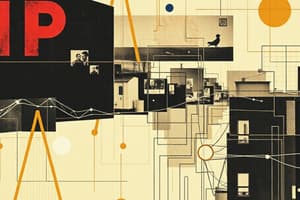Podcast
Questions and Answers
What approach does fourth-generation software typically use in programming?
What approach does fourth-generation software typically use in programming?
- Procedural Programming
- Functional Programming
- Event-Driven Programming
- Structured Programming (correct)
What significant development occurred in fifth-generation software?
What significant development occurred in fifth-generation software?
- Dominance of the Microsoft Windows OS (correct)
- Development of Spreadsheets
- Utilization of Cobol Programming
- Introduction of Assembly Language
What are two main types of programmers mentioned in the context of computing as a tool?
What are two main types of programmers mentioned in the context of computing as a tool?
- Systems Programmer and Applications Programmer (correct)
- Network Administrator and Database Analyst
- Web Developer and Systems Engineer
- Software Architect and Application Designer
What skill is essential for efficiently expressing problems as step-by-step procedures?
What skill is essential for efficiently expressing problems as step-by-step procedures?
What type of programs are typically included in the new application software developed during the fourth generation?
What type of programs are typically included in the new application software developed during the fourth generation?
Which early computing device was used for basic arithmetic calculations?
Which early computing device was used for basic arithmetic calculations?
Who is known as the first programmer?
Who is known as the first programmer?
In computing, what purpose does a utility program serve?
In computing, what purpose does a utility program serve?
What is the primary function of an operating system?
What is the primary function of an operating system?
What was a significant characteristic of vacuum tubes used in first-generation hardware?
What was a significant characteristic of vacuum tubes used in first-generation hardware?
Which language is an example of one used during the era of structured programming?
Which language is an example of one used during the era of structured programming?
What abstract mathematical model did Alan Turing invent?
What abstract mathematical model did Alan Turing invent?
Which device is known for introducing punched cards in computing?
Which device is known for introducing punched cards in computing?
What type of storage did the magnetic drum serve as?
What type of storage did the magnetic drum serve as?
Which of the following accurately describes Ada Lovelace's contribution to computing?
Which of the following accurately describes Ada Lovelace's contribution to computing?
What was a primary use of early computers like the UNIVAC I?
What was a primary use of early computers like the UNIVAC I?
What are the main components of a computing system?
What are the main components of a computing system?
What is the purpose of an operating system in a computing system?
What is the purpose of an operating system in a computing system?
How does abstraction function in computing?
How does abstraction function in computing?
Which layer of a computing system focuses on specific real-world problem-solving?
Which layer of a computing system focuses on specific real-world problem-solving?
What is the difference between systems programmers and applications programmers?
What is the difference between systems programmers and applications programmers?
What does the term ‘computing’ refer to in this chapter?
What does the term ‘computing’ refer to in this chapter?
Which statement best describes hardware in a computing system?
Which statement best describes hardware in a computing system?
What role does communication play within computing systems?
What role does communication play within computing systems?
What technology replaced vacuum tubes due to its advantages such as speed and durability?
What technology replaced vacuum tubes due to its advantages such as speed and durability?
Which hardware technology replaced magnetic drums by providing instant information availability?
Which hardware technology replaced magnetic drums by providing instant information availability?
What significant development emerged in the fourth generation of hardware (1971 onwards)?
What significant development emerged in the fourth generation of hardware (1971 onwards)?
What programming language type was widely used from 1951 to 1959 and involved writing programs in binary?
What programming language type was widely used from 1951 to 1959 and involved writing programs in binary?
Which language layer in the first generation of software was primarily written using mnemonics?
Which language layer in the first generation of software was primarily written using mnemonics?
What was a major advancement in computing during the late 1980s with regards to networking?
What was a major advancement in computing during the late 1980s with regards to networking?
What programming methodologies divided programmers into application and systems programmers during the first generation of software?
What programming methodologies divided programmers into application and systems programmers during the first generation of software?
Which high-level programming languages emerged during the second generation of software (1959-1965) to simplify programming?
Which high-level programming languages emerged during the second generation of software (1959-1965) to simplify programming?
Flashcards are hidden until you start studying
Study Notes
Chapter Goals
- Understand the layers of a computer system.
- Learn the concept of abstraction and its significance in computing.
- Explore the history of computer hardware and software.
- Recognize the evolving role of computer users.
- Differentiate between systems programmers and applications programmers.
- Distinguish computing as a tool versus computing as a discipline.
Computing Systems
- A computing system is a dynamic entity designed for problem-solving and environmental interaction.
- Components of a computing system include hardware, software, and data.
Layers of a Computing System
- Information Layer: Represents how information is stored and communicated on a computer.
- Hardware Layer: Encompasses physical components such as printers and keyboards.
- Programming Layer: Involves software that governs computations and data management.
- Operating Systems: Facilitate user interaction with hardware and manage data and programs (e.g., Windows, Linux).
- Applications Layer: Focuses on utilizing computers for solving real-world problems.
- Communication Layer: Vital for data exchange and fundamental operations within computing systems.
Abstraction
- Abstraction is a mental model that simplifies complex details, crucial in understanding computing concepts.
History of Computing
- Abacus: Early device for recording numeric values.
- Blaise Pascal: Developed a mechanical calculator for basic arithmetic operations.
- Joseph Jacquard: Innovated the Jacquard Loom using punched cards for automation.
- Charles Babbage: Known for the Analytical Engine, an early mechanical computer.
- Ada Lovelace: Recognized as the first programmer and conceptualized the loop in programming.
- Alan Turing: Created the Turing Machine, providing a foundational mathematical model for computation.
- Early Computers: Harvard Mark I, ENIAC, and UNIVAC I marked the dawn of modern computing.
Generations of Hardware
- First Generation (1951–1959): Utilized vacuum tubes, magnetic drums, and card readers.
- Second Generation (1959–1965): Introduced transistors, magnetic cores, and magnetic disks, enhancing efficiency and reducing size.
- Third Generation (1965–1971): Featured integrated circuits which improved reliability and performance.
- Fourth Generation (1971–present): Saw the rise of personal computers and workstations, making technology widely accessible.
Parallel Computing and Networking
- Parallel Computing: Involves interconnected processors or memory units to enhance processing speeds.
- Networking: Early systems like ARPANET led to the development of the Internet, allowing resource sharing.
Generations of Software
- First Generation (1951–1959): Focused on machine language, assembly languages, and early programming divisions.
- Second Generation (1959–1965): Emerged high-level languages such as Fortran and COBOL, facilitating programming ease.
- Third Generation (1965–1971): Systems software including translators and operating systems became prevalent.
- Fourth Generation (1971–1989): Structured programming became standard with languages like Pascal and C++.
- Fifth Generation (1990–present): Dominated by Microsoft, emphasizing object-oriented design and global communication via the Internet.
Computing as a Tool vs. Discipline
- Systems programmers create tools while applications programmers utilize them.
- Necessary Skills for Computing as a Discipline:
- Algorithmic Thinking: Develop step-by-step solutions to problems.
- Representation: Efficient data storage and processing methods.
- Programming: Combining algorithmic thinking and representation into software solutions.
Studying That Suits You
Use AI to generate personalized quizzes and flashcards to suit your learning preferences.




